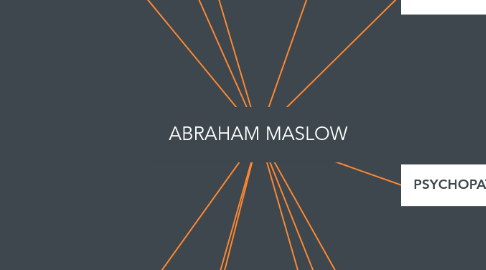
1. VIEW OF PERSONALITY
1.1. Human Motivation
1.1.1. Holistic approach to personality
1.1.2. Motivation is complex
1.1.3. Continually motivated by one need or another
1.1.4. All people are motivated by the same basic needs
1.1.5. Needs are arranged on a hierarchy
2. Human Nature
2.1. Optimistic view of human nature
2.2. Human needs are weak and feeble, they whisper rather than shout
3. HIERARCHY OF NEEDS
3.1. Self Actualization
3.1.1. Self Fulfillment
3.2. Self Esteem
3.2.1. Psychological Needs
3.3. Belonging & Love
3.3.1. Psychological Needs
3.4. Safety
3.4.1. Basic Needs
3.5. Physiological Needs
3.5.1. Basic Needs
4. GENERAL CONSIDERATIONS ON NEEDS
4.1. Reversed order of needs
4.1.1. Occasionally needs are reversed
4.2. Unmotivated Behaviour
4.2.1. Some behaviours are not motivated
4.3. Deprivation of Needs
4.3.1. Leads to pathology
4.4. Instinctoid Nature of Needs
4.4.1. Human needs are innate but can be determined by learning
4.5. Deficit needs
4.5.1. Failure to satisfy lower needs
4.6. Aesthetic needs
4.6.1. Motivated by the need for beauty
4.7. Cognitive needs
4.7.1. Desire to know, understand
4.8. Neurotic Needs
4.8.1. Lead to stagnation and pathology
4.9. Self Actualisation
4.9.1. Fullest development of the self
4.9.2. Criteria for Self Actualisation
4.9.2.1. Free from Psychopathology
4.9.2.2. Progressed through the hierarchy of needs
4.9.2.3. Embracing of B values
4.9.2.3.1. Truth,Goodness,Beauty,Perfection, Justice etc..
4.9.2.4. Full use and exploitation of talents, capacities etc.
5. DESACRALIZATION
5.1. Science that lacks emotions, joy, values etc…
6. TAOISTIC ATTITUDE
6.1. Noninterfering, passive and receptive
7. LIFE
7.1. Born on April 1, 1908 in New York
7.2. 1st of seven children born of Jewish parents from Russia
7.3. Briefly studied law at CCNY
7.4. Married Bertha and had two daughters
7.5. Taught at Brandeis University
7.6. President of the APA from 1967 to 1968
7.7. Published motivation and personality in 1970
7.8. Founded American Association of Humanistic psychology in 1962
7.9. 1967 had a fatal heart attack
8. PHILOSOPHICAL BASE
8.1. Existentialism
8.2. Phenomenology
8.3. Humanism
9. PSYCHOPATHOLOGY
9.1. Failure to gratify fundamental needs
9.1.1. Symptoms
9.1.1.1. Guilt, Shame or anxiety
9.1.1.2. Guilt, Shame or anxiety
9.1.1.3. Apathy, hopelessness
9.1.1.4. Faulty conception of oneself and environment
9.1.1.5. Excessive dependence
9.1.1.6. Fear of knowledge of oneself & others
10. PSYCHOTHERAPY
10.1. Therapeutic Procedures
10.1.1. Adopts eclectic approach
10.1.2. Therapist - genuine, accepting, kind, sympathetic, emotionally secure, concerned etc..
10.1.3. Accepts the existence of resistance and transference also countertransference
